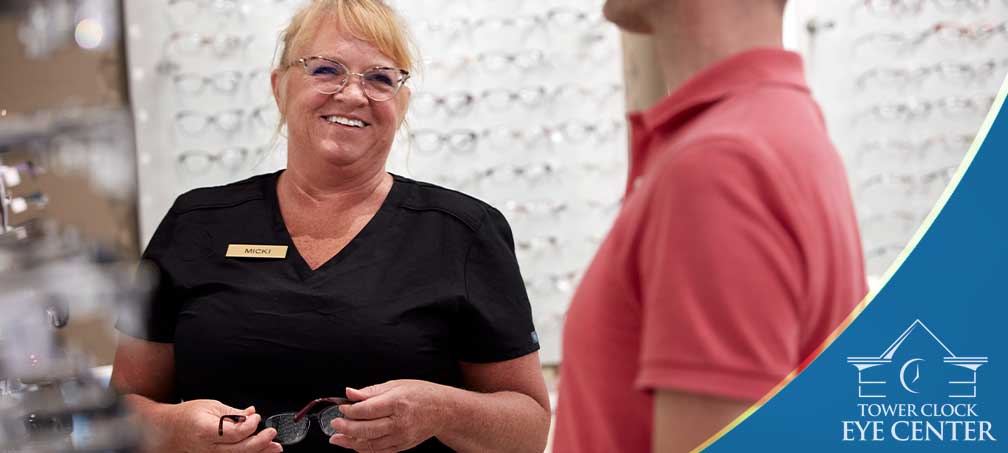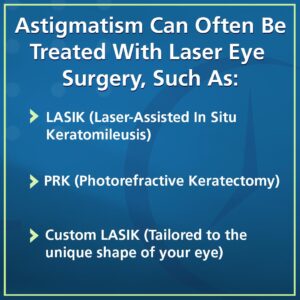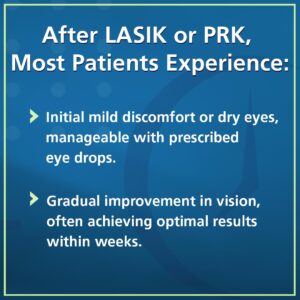
What Is Astigmatism?

While many people may not realize they have astigmatism at first, it’s often discovered during a routine eye exam for glasses or contacts. In fact, astigmatism can also occur alongside other vision issues like nearsightedness (myopia) or farsightedness (hyperopia), making it even harder to notice at first.
If you’ve been experiencing problems with your vision, it’s a good idea to schedule a comprehensive eye exam. Call us today at 920-221-0301.
What Causes Astigmatism?
The exact cause of astigmatism isn’t fully understood, but genetics plays a significant role. In many cases it’s inherited, meaning it runs in the family. However, other factors can contribute to the development of astigmatism, including:
- Injuries or Surgeries: Any trauma or surgery that alters the shape of the cornea can cause astigmatism. Even something as simple as a scratch or wound on the cornea can lead to a change in its shape.
- Keratoconus: This condition occurs when the cornea gradually thins and becomes more cone-shaped. This can significantly distort vision, leading to worsening astigmatism.
- Scarring or Infections: Eye infections, particularly those that affect the cornea, can lead to scarring and cause irregularities in the corneal shape, resulting in astigmatism.
- Environmental Factors: Though rare, prolonged eye strain, exposure to harsh environmental conditions, or even certain habits can potentially exacerbate astigmatism.
Though the underlying cause can vary from person to person, the good news is that astigmatism is treatable through a variety of solutions.
How Do I Know If I Have Astigmatism?

- Blurry or Distorted Vision
- Eye Strain and Discomfort
- Frequent Headaches
- Difficulty Seeing in Low Light
While these symptoms can indicate astigmatism, the only way to confirm the diagnosis is by scheduling a comprehensive eye exam.
Astigmatism Treatment
Fortunately, there are several ways to treat astigmatism and improve your vision. These treatments can give you clearer sight and make navigating through life a lot easier. From simple corrective eyewear to advanced surgical procedures, there’s a solution that’s right for you.
1. Corrective Eyewear
- Glasses: Prescription glasses are a simple and effective solution. They use special lenses to correct how light focuses on your retina, helping you see clearly again.
- Contact Lenses: For those who prefer not to wear glasses, toric contact lenses are specifically designed to correct astigmatism. Their unique shape allows light to focus properly on the retina. For some people, rigid gas-permeable or hybrid lenses may provide better results.
2. Laser Vision Correction
If you’re looking for a more permanent solution, laser eye surgery can be an excellent choice. There are a few options to consider:
- LASIK (Laser-Assisted In Situ Keratomileusis)
- PRK (Photorefractive Keratectomy)
These procedures are performed using state-of-the-art equipment by skilled surgical teams, ensuring clear vision and long-term relief.
The Role of LASIK and Refractive Surgery

During LASIK, the surgeon creates a small flap in the cornea and uses a laser to reshape the underlying tissue. This helps correct the irregularities in the cornea that cause astigmatism, allowing light to focus properly on the retina.
Tower Clock Eye Center’s Premium LASIK takes this a step further by using advanced technology to map the unique shape of your eyes. This personalized approach is especially beneficial for those with higher degrees of astigmatism or more complex vision needs. Whether you opt for traditional LASIK or Custom LASIK, both treatments can effectively address astigmatism and help you achieve your best possible vision.
3. Cataract Surgery
Astigmatism can be treated along with cataracts to provide more independence from glasses. The surgeon takes the extra step of reducing the amount of astigmatism by utilizing advanced technology during the cataract surgery.
4. Refractive Lens Exchange (RLE)
In RLE the natural lens is removed from the eye and replaced with astigmatism correcting intraocular lens (IOL).
Importance of Advanced Technology

At Tower Clock Eye Center, we use the latest technology to ensure the best possible results for our patients. Tools like wavefront sensors and custom LASIK platforms allow our surgeons to create a precise treatment plan that is tailored to your unique eye shape. This advanced technology not only ensures accuracy but also helps to reduce the need for corrective eyewear in the future.
Preparing for Your Procedure
Before undergoing surgery, it’s essential to have a comprehensive eye exam and consultation with your surgeon. During this process, your doctor will assess your eye health and discuss any symptoms you may be experiencing. This is also the time to ask about your vision goals and whether LASIK, PRK, RLE or another procedure is right for you.

Recovery Process
The recovery process can vary depending on the procedure you choose. For most LASIK and PRK patients, the recovery time is relatively short:
- Mild Discomfort: After surgery, you may experience mild discomfort or dry eyes, which can be easily managed with eye drops.
- Gradual Improvement: Vision typically improves over the first few weeks, with many patients achieving optimal results within a month.
Following your surgeon’s post-operative care instructions is crucial to ensure proper healing and to achieve the best long-term results.
Contact Our Eye Center Today
If you’re struggling with vision correction or want to learn more about LASIK or other refractive eye surgeries, we’re here to help! Tower Clock Eye Center offers comprehensive eye exams, advanced treatments, and laser vision correction throughout Northeast Wisconsin and serves Michigan’s Upper Peninsula. Whether you’re interested in LASIK or another procedure, we’re committed to helping you achieve excellent vision.
Call us today at (920) 499-3102 to schedule a consultation and take the first step toward sharper, brighter vision. Don’t let astigmatism hold you back. Explore our advanced vision correction options and start your journey toward a future with clearer vision.
